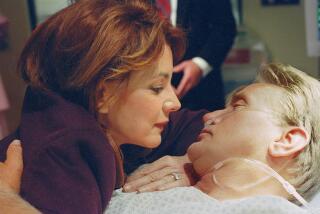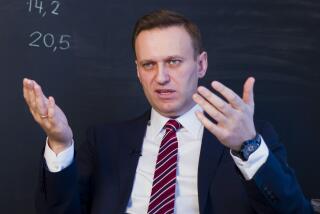Cheney Gave Order to Shoot Down Jets
- Share via
WASHINGTON — Vice President Dick Cheney was huddled with top U.S. officials in a bunker below the White House on the morning of Sept. 11, 2001, when a military aide told him that a hijacked aircraft was 80 miles from Washington and closing in fast. The aide needed to know: Did Cheney want to give warplanes scrambled over Washington orders to shoot it down?
Cheney did not hesitate. He authorized fighter aircraft “to engage the inbound plane.”
In the decision to issue a lethal order without precedent in American history -- to shoot down a plane filled with American civilians -- Cheney both struggled with the confusion of that morning and personified it, according to a staff report issued Thursday by the national commission investigating the terrorist attacks.
The order given by Cheney was never received by the fighter pilots, and, in the end, it came too late to interrupt the assault.
Perhaps in his haste to act -- President Bush was in Florida at the time -- Cheney might have shortcut White House protocol, the report said. The normal chain of command for military “engage” orders goes from the president to the secretary of Defense, and not through the vice president, it said.
Although Cheney said he conferred with the president before giving the order, the commission staff could not confirm that a phone call took place in that time frame. Several minutes after giving the order, Cheney informed Defense Secretary Donald H. Rumsfeld that he had done so.
“So we’ve got a couple of aircraft up there that have those instructions at the present time?” Rumsfeld asked.
“That is correct,” Cheney replied. “And it’s my understanding they’ve already taken a couple of aircraft out.” That understanding turned out to be mistaken.
By then, three hijacked airliners had already been crashed into the World Trade Center and the Pentagon. The airliner Cheney ordered shot down had already been forced by passengers to crash in a Pennsylvania field. And another seemingly hostile aircraft turned out to be a medevac helicopter, headed to the Pentagon.
The events at the White House underscored the chaotic nature of a day that was filled with events the nation had never encountered and was not prepared to meet, the report said.
Just before 9 that morning, Cheney was seated in his White House office for a meeting with his speechwriter when an aide came in and told him to turn on the television. A plane had just struck the World Trade Center.
“The vice president was wondering ‘how the hell a plane could hit the World Trade Center’ when he saw a second aircraft strike the South Tower,” according to the commission staff report.
After that, things started happening quickly. According to accounts Cheney had given earlier, he called Condoleezza Rice, national security advisor; Mary Matalin, his top aide; and other advisors to his office. The group was interrupted by Secret Service agents, who grabbed Cheney and moved him “very rapidly” down several flights of stairs to a tunnel deep under the White House.
Halfway down the tunnel was a secure telephone, a bench and a television. Cheney asked to speak to the president. By the time the call was connected, according to the report, Cheney had flipped on a television to see smoke pouring out of the Pentagon.
With his wife, Lynne, who had been brought to the bunker by Secret Service agents, at his side Cheney told Bush of the three planes missing and of the hit on the Pentagon. In what would be the first of a series of counsels, he urged Bush not to return to Washington.
Bush had resisted the idea of staying away, according to the commission’s chronology. But Cheney was persuasive. After the two got off the phone, Air Force One would take off from a Florida airport with no destination in mind, its only instructions to get airborne and fly high and fast enough to reach safety.
From the command conference room in the bunker, according to witnesses, Cheney quickly sought to take charge.
Cheney has told the commission that during one call to Bush, moments after he arrived at the command center, he asked the president to decide on the rules of engagement for combat planes being deployed over Washington. Bush said he authorized that hijacked planes be shot down.
But the commission staff seemed to question whether the call took place. Its report noted that there were no logs of that phone call between Cheney and Bush. “Others nearby who were taking notes, such as the vice president’s chief of staff, [I. Lewis] Scooter Libby, who sat next to him, and Mrs. Cheney, did not note a call between the president and vice president immediately after the vice president entered the conference room,” the report said.
Lee H. Hamilton, co-chairman of the Sept. 11 commission, told reporters “there’s no documentary evidence” that Cheney conferred with Bush before issuing the shoot-down order.
“And the only evidence you have is the statement of the president and the vice president, which was that the president gave the order to shoot down,” Hamilton said.
Among those at the conference table in the bunker was White House Deputy Chief of Staff Joshua Bolten.
According to the commission report, Bolten watched the exchanges between Cheney and his military aide as they monitored the progress of what they thought was United Airlines Flight 93. The jet actually had crashed in Pennsylvania at 10:03 a.m., but military officials did not learn of the crash until later.
Sometime between 10:10 a.m. and 10:15 a.m., the Cheney aide said the aircraft was 80 miles out and Cheney was asked for authority to shoot down the plane. He issued the order, the commission staff said. Minutes later, the military aide reported that the plane was 60 miles out and Cheney again was asked for authorization. Again, he said yes.
“And after what he called ‘a quiet moment,’ [Bolten] suggested that the vice president get in touch with the president and confirm the engage order.” The vice president is logged, at 10:18 a.m., as making a two-minute call to the president that obtained that confirmation.
Bolten, the report noted, “said he had not heard any prior conversation on the subject with the president.”
Cheney’s group got word later that a plane was down in Pennsylvania, and people in the conference room wondered whether it had been shot down at Cheney’s direction, according to the report.
About 10:30 a.m., officials with Cheney began getting reports of another hijacked plane, five to 10 miles out. Cheney issued yet another order to engage the aircraft, but it turned out to be the medevac helicopter.
Meanwhile, in the skies over Washington, two F-16s, scrambled from Virginia’s Langley Air Force Base, were armed and under the control of the North American Aerospace Defense Command. But the Langley pilots were never told why they were sent up.
“In short, while leaders in Washington believed the fighters circling above them had been instructed to ‘take out’ hostile aircraft, the only orders actually conveyed to the Langley pilots were to ‘ID type and tail’ ” -- identify the aircraft and follow them, the commission concluded.
In the absence of clear guidance, the pilots didn’t know what to think.
At one point they thought they were looking for an incoming Russian missile.
“I reverted to the Russian threat,” the lead pilot told the commission staff. “I’m thinking, cruise missile threat from the sea. You know you look down and see the Pentagon burning and I thought, the bastards snuck one by us.... You couldn’t see any airplanes, and no one told us anything.”
Soon after, Cheney told Rumsfeld of his mistaken belief that “a couple” of planes had been shot down.
Rumsfeld replied: “We can’t confirm that. We’re told that one aircraft is down but we do not have a pilot report that they did it.”
More to Read
Sign up for Essential California
The most important California stories and recommendations in your inbox every morning.
You may occasionally receive promotional content from the Los Angeles Times.










